Small spaces can help wildlife on their journeys by providing rest, food, water, and places to hide along their way. Elevated habitats, such as balconies and roofs, can provide space for birds and insects, while ground-level habitats benefit amphibians and small mammals too. With more spaces available for wildlife we can increase biodiversity, strengthen habitat connectivity, and decrease pressures on wildlife.
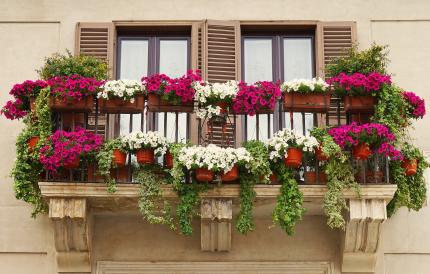
What makes a habitat?
- Food: Plants are the best food source for many wildlife species. In addition to providing food, plants can also attract insects who can benefit wildlife.
- Water: All wildlife need water to survive, either from natural or provided sources.
- Shelter: Wildlife need a place to rest and escape from the weather and predators. Planting native plants at varying heights benefits wildlife.
- Space: Wildlife need space to raise young and survive. Overhead cover can often double as a place for wildlife to raise their young. Bird houses, small trees, shrubs, or plants for pollinators help too.
By creating wildlife habitat at home, you can help offset habitat lost to housing and urban development in Washington. Even small spaces can help decrease habitat fragmentation, especially in highly urbanized areas. Habitat fragmentation happens when areas of suitable habitat are separated from one another. Urban development often leaves wildlife without pathways to safely move between habitats. We can help bridge these gaps by providing more space for wildlife to live and move through.
The Habitat at Home program is free and open to all Washington residents.
Apply for a Habitat at Home sign
Download a printable sign application (PDF)
Container gardens

By planting in pots or containers, you can add plants that benefit wildlife and maintain a mobile garden. Container gardens are great for renters or others who need a gardening system that they can move if necessary. Container gardens can provide habitat on balconies, porches, patios, roofs, and also enhance your health and well-being by creating a natural space to relax and enjoy nature right at home.
Container plants need well drained soil and need to be watered more often than plants in the ground. Set a schedule to care for your garden in the dry months or if your plants are undercover and don't get rain. Start with our list of native plants (PDF) that can thrive in container gardens.
Vertical gardens
Make the best use of the space you have by thinking up, not out! By planting in layers and using vertical space such as walls, siding, fences, and rails, you can create a useful wildlife oasis even if your space is small.
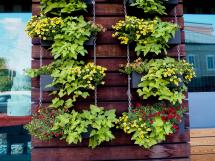
Hanging baskets, pots that attach to rails or fences, and lattices all allow you to plant above ground level. There are also options for providing feeders, housing, and water for animals by hanging or attaching items to walls and rails. Be creative in the space you have and keep your plant species varied to support the most wildlife.
Resources for small-space habitats
- Small Space Native Plant List (PDF)
- Container Gardening for Kitchen and Wildlife webinar
- Creating a Balcony Garden for Pollinators
- Keystone Plant Lists for Container Gardens
Already created native wildlife habitat in your space? Apply for our certification and Habitat at Home sign. Our program is free and open to all wildlife habitat types.
Visit our Living With Wildlife webpages to learn more about the species you might see in your habitat, how to coexist with wildlife in urban, suburban, and rural places, and ways you can adapt your space to prevent wildlife conflict.
The Community Science at Home webpage has great ways to observe wildlife and contribute to community science, right where you live, work, and play!
Native Plants
Gardening with native plants benefit both you and your local wildlife. A native plant is one that occurs naturally in a specific geographic region or habitat and was not brought there by humans. These plants have evolved alongside Washington’s wildlife and are adapted to local environmental conditions. Native plants are low maintenance, decrease pollution, and benefit wildlife and the environment.
New to gardening? Download our starter packet for Habitat at Home (PDF) to learn more about soil, plant placement, seeds, and more!
Native plants are low maintenance
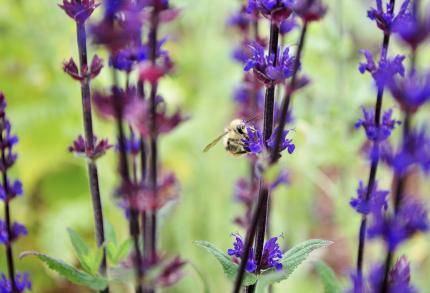
Native plants are adapted to the local rainfall and other environmental conditions. They can be hardier than exotic plants and will thrive without the use of pesticides or fertilizers. Native plants are also better at combatting weeds than non-native plants! Their minimal care and maintenance requirements make them a great addition to any garden. In small spaces, choose plants that will have varying heights when full grown. A mix of ground covers, flowers, and taller shrubs will help support a wider variety of species in a small space.
Native plants decrease pollution
Some native plants are more efficient at removing carbon dioxide from the air than non-native plants due to their deep root systems which allow them to store more carbon. Native plants also support more native insects, like pollinators and insects birds feed on.
Native plants benefit wildlife and environment
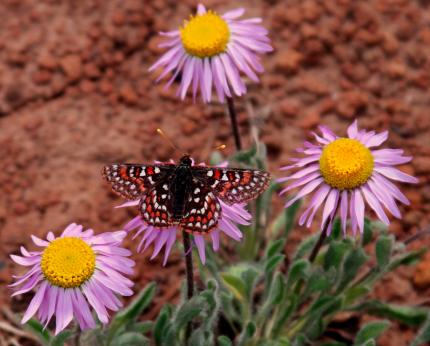
Native plants are best suited to support the wildlife they evolved alongside. They support a greater number of species and life cycles than non-native plants. Research shoes that native plants are four times more attractive to pollinators than non-natives. Native oaks support more than 550 different species of butterflies and moths alone, while some non-native species support as little as five. By providing local wildlife with plants better suited to support their habitat needs, we can increase their chances of survival.
Native plants for containers*
Container gardens can come in all shapes and sizes but when planning your garden, get the largest containers you can for your available space. Download the Small Space Plant List (PDF).
Herbs and Flowers
- Common yarrow (Achillea millefolium)
- Foam flower (Tiarella trifoliata)
- Snow buckwheat (Eriogonum)
- Piggy-back plant (Tolmiea menziesii)
- Star-flowered Solomon's-seal (Maianthemum stellatum)
- Beardtongue - various (Penstemon serrulatus, Penstemon ovatus)
- Miner's lettuce (Claytonia perfoliata)
- Lyall's mariposa lily (Calochortus)
- Fleabanes (Erigeron: poliospermus, aliceae, salishii)
- Red columbine (Aquilegia formosa)
- Coneflowers - various (Rudbeckia)
- Camas/quamash (Camassia)
- Columbia lily (Lilium columbianum)
- Small-flowered alumroot (Heuchera micrantha)
- All 11 varieties of native Washington iris (Iris)
Groundcovers
- Stonecrop – various (Sedum)
- Nettleleaf giant hyssop (Agastsache urticifolia (PDF))
- Hedgenettles - various (Stachys)
- Deer fern (Blechnum spicant/Struthiopteris spicant)
- Wild strawberry – various (Fragaria)
- Idaho blue-eyed grass (Sisyrinchium idahoense) & Golden-eyed grass (Sisyrinchium californicum)
- Munro’s globemallow (Sphaeralcea munroana (PDF))
Shrubs/trees
- Red flowering currant (Ribes sanguineum var. sanguineum)
- Thimbleberry (Rubus parviflorus)
- Oregon grape (Berberis aquifolium)
- Beaked hazelnut (Corylus cornuta)
- Orange honeysuckle (Lonicera: hispidula, ciliata)
- Red-osier/red twig dogwood (Cornus stolonifera/sericea)
- Kinnickinnick (Arctostaphylos uva-ursi)
- Mock orange (Philadelphus lewisii)
- Evergreen huckleberry (Vaccinium ovatum)
- Hairy manzanita (Arctostaphylos columbiana)
- Wild lilac - various (Ceanothus)
- Willow - various (Salix)
*Plant lists curated by Washington Native Plant Society/Walter Fertig and Claire Kerwin (WDFW)
Where to find native plants in Washington
You can find native plants at many nurseries and retailers, but it can be difficult to know what to look for if you're not prepared before you go. Many county conservation districts offer native plant sales in early spring or fall and can help you decide what to look for based on your needs.
Food
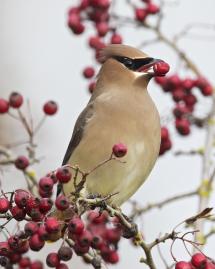
Plants are the best food source for wildlife
In addition to directly providing food, plants can also attract insects who benefit wildlife. Feeders can be used to supplement wildlife diets but cannot provide for them fully. Consider a variety of plants that can provide food year-round for wildlife. Pay attention to what your backyard wildlife are eating and adjust accordingly!
National Audubon has a native plant search engine. Enter your zip code and it will provide several lists to guide you through choosing plants suited to your area. It will give you a list best for birds and other wildlife, a list of all native plants in your area, and a resource page with your closest Audubon location (to reach out to with questions), native plant nurseries, seed sellers, and more local resources.
Remember – wildlife have developed adaptations that allow them to survive harsh winter conditions without human intervention. The best way to help wildlife survive a severe winter is to promote year-round quality habitat. Feeding wildlife food is never a good idea, even when it seems that other available food sources may be scarce.
Looking to get started with native plants? Download our starter packet for Habitat at Home (PDF) to learn more about soil, plant placement, seeds, and more!
Supplemental feeders
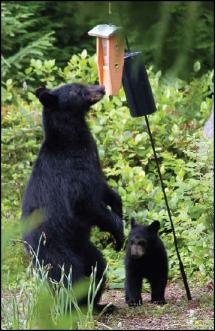
Wildlife feeders need to be seasonally maintained. Bird feeders often bring in wildlife other than just the birds they are intended for. It important to know who you might draw in and what times of year the species are active so that you can make the best choice for your habitat.
For this reason, do not use feeders with nuts, salt licks, or feed your pets outdoors. All of these food sources attract many species and the predators who hunt them. Learn more about feeding and living alongside Washington wildlife species on our Living with Wildlife pages.
Birds need a wide variety of food sources to provide the nutrients they need. Seeds fill just one part of that need. Along with seed feeders, it is important to provide native plants that can help fill those other gaps through fruits and insects, especially caterpillars, which make up a large percentage of baby bird diets.
Water
All wildlife need water to survive. Some species get their hydration from the foods they eat, and some drink from water that collects in leaves and flower blooms. Providing water is a crucial element of your wildlife habitat. As droughts linger and temperatures rise, natural ways to access water are not always available. We can help by adding water features year-round or only in times of need. Learn how to create a container water garden.
Insect and puddling dishes
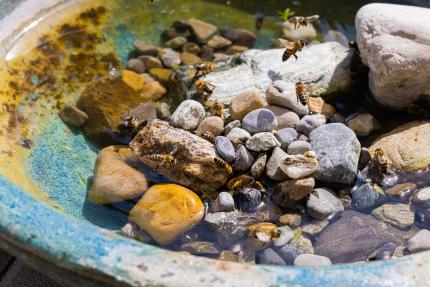
When temperatures are high water evaporates quickly from leaves and flowers. During this time, pollinators such as bees and butterflies will often use water dishes or shallow bird baths.
- Puddling Dishes: Puddling dishes are used by butterflies to drink water and extract minerals. Fill a shallow dish with a mix of sand, soil, or compost. Add water to create mud. Place the dish either in the ground or higher on a flat surface. Check often to keep it moist. Avoid overfilling to keep standing water from sitting and attracting mosquitoes.
- Insect watering dish: In a shallow dish place a variety of stones of various sizes. Fill the dish with an inch of water. The stones allow insects and small birds to land and drink safely. Drain completely and replace water every two to three days to keep it clean and avoid mosquitoes.
Bird baths
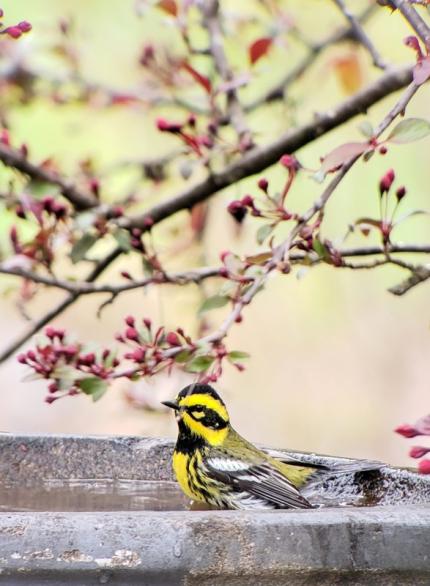
A great way to help and view wildlife are bird baths. Bird baths are best set up in the shade where small birds can use them without fear of predators from above.
Slopes: Birds prefer to wade in gradually, so consider a container with slightly sloped sides. You can also place pebbles in the bottom to create shallow and deep sections.
Dry edges/areas: These spaces are important to have on your bath so birds have a place to stand when drinking, to dry off, or perch before bathing. Pebbles placed at the bottom that are large enough for birds to stand on without getting wet also work.
Textured bottom: Birds prefer baths that have some grip on the bottom so they don't slip. Try using a terra cotta or concrete surface or placing pebbles on the bottom.
Temperature: When choosing a spot to place your water feature, consider how much sun that spot will get. In the winter, a sunny spot might be great. In the summer, a full-sun spot may become too warm, especially if your water feature is constructed out of a material that gets hot easily.
Running water: The sound of running water is a great way to attract wildlife. Explore options for small fountains (pet fountains work too!), bird bath drippers, and misters to place in your habitat. Running water also helps prevent insects (like mosquitoes) from laying eggs and can help prevent water from freezing in the winter.
Cleaning: Making sure you regularly clean your water feature is critically important to preventing diseases from spreading between wildlife. To ensure your water feature remains clean, keep debris like pine needles, leaves, or bird seed out of the water, opt for a feature with running water, and scrub with soap and water once a week.
Extreme heat
During heat waves, consider these extra steps to “take the heat off” our wild neighbors.
-
Put out extra water dishes of various sizes; hiding them under shrubs and plants to give animals various places to find both shelter and a drink. If wildlife doesn’t have to expend energy searching out water, they will be able to handle the hot temperatures for longer.
-
Refill water sources more often. Heat will evaporate water more quickly and smaller species might not get a chance to drink.
-
Move bird baths into the shade to reduce water temperatures and make the water last longer.
-
Leave water out and filled at night. In extreme heat some species will shift their activity times to night, when they can move safely move throughout their territories.
Shelter
Wildlife need places to rest, escape from the weather, and hide from predators. They also need safe places to raise their young. Some examples of good shelter in small spaces include providing plants of various heights to create layers; hanging bird, bee, or bat houses; and providing rock piles. Trees are essential shelter for many species - work with your city, homeowner’s association, or local community to steward trees near you.
Plant layers for wildlife
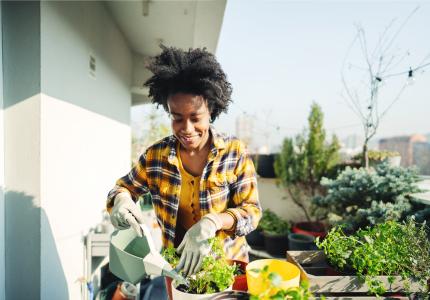
Even small space habitats can help wildlife by providing extra spaces for small wildlife species to live, shelter, and survive. Think about your plants in layers to support different species. Planting ground cover allows animals to shelter on the ground.
Small shrubs are big enough for birds to hide inside and can support the weight of birds who prefer to sit on branches or on top of sheltered areas, like spotted towhees and song sparrows. Birds will often use shelter to wait for the opportune moment to fly to a feeder or feed on a plant. Insect pollinators will use plants for nectar and pollen for food, as a place to lay eggs, and as a resource for new young to eat fresh foliage to sustain themselves through the immature stages of their growth.
Bird houses
Hanging or wall mounted bird houses are perfect for small spaces. Try to look at the bird species already seen in your neighborhood, and choose a house that will work for those species. Remember to clean out birds houses annually.
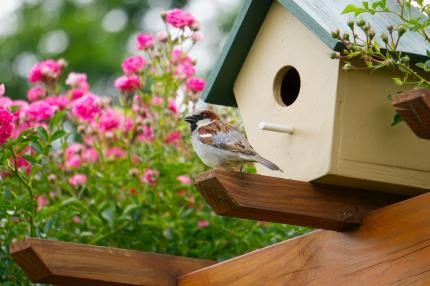
Nest Watch helps you find the right bird house for birds in your region and habitat. WDFW has Woodworking Project Plans for many local species.
Bat houses
A bat house is a great way to provide daytime shelter to bats during spring and fall transitions. When installing a bat house, look for a place on your building that receives up to six hours of sun, is high enough to be safe from predators, and is not directly over a walkway or living space. Learn more about finding the right place for a bat house with WDFW's Care and Installation guide (PDF) and visit our blog to learn about how bats use bat houses. WDFW has building plans for bat houses designed for Washington and lots of information to learn more about bats in Washington.
Bee hotels
Providing a bee hotel or bee box can be a great way to support native solitary bees in your area. Bee hotels are structures with holes and hollowed out stems for cavity nesting bees to rest and reproduce. In Washington, bee hotels will attract bees like mason bees, leaf cutter bees, and carder bees. Place your bee hotel away from areas that receive heavy traffic like doorways or paths.
One of the best things you can do is adjust your gardening practices to increase nesting habitat for pollinators. Instead of raking leaves as soon as they fall, leave them in natural spaces. Remove them from walkways and place the excess leaves at the base of trees. When flowers die at the end of the season, trim off the heads but leave the stems attached.
Rock piles and small shelters

Rock and stick piles make great habitat for some of our smallest species such as amphibians, reptiles, and insects. These are easy elements to include in any size space. Add a small pile of rocks to a container or build a rock wall into your garden. Including logs in your landscape create a whole ecosystem to support wildlife. Some animals will use dug out holes for dens and winter shelters. Leaf piles benefit many of our native pollinators when left through the winter and early spring. Learn how to make a toad abode.
A source of cover can often double as a place to raise young wildlife. Bird houses, small trees, shrubs, or plants for pollinators are all good examples. You can also provide nesting materials such as yarn, pet hair, dried grass, and straw.
Sustainable Practices
There are many simple ways to practice resource conservation in your Habitat at Home!
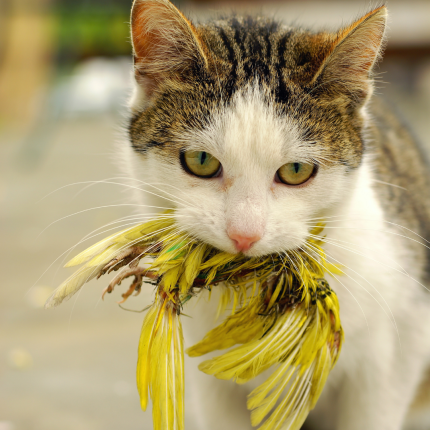
1. Keep cats indoors
Domestic cats are talented predators. Because of their efficient hunting tactics, housecats kill millions of birds, reptiles, amphibians, and small mammals which impacts local wildlife populations dramatically. Additionally, cat feces can spread disease to wildlife. Instead of letting your cats outside, build them a contained outdoor catio or provide enrichment inside. Keeping cats indoors keeps both your cats and local wildlife safer. Visit the American Bird Conservancy website for information on their "Cats Indoors!" program.
2. Reduce or eliminate chemical use
Predators who prey on rodents, like owls, can be poisoned by eating prey that has eaten rodenticides. This not only harms predators, but can cause prey populations to increase, leaving you with more rodents than you started with. Use chemical-free options like snap traps.
3. Choose pesticide-free plants
Look and ask your nurseries for plants that not treated with pesticides. In many nurseries raised plants, pesticides are present throughout the entire plant it has been treated with it (even if the label says “wildlife friendly”). This includes floral nectar and pollen. Even low levels of pesticides can have an impact on insect pollinators. Check with your nursery to verify this information if you can't find it on the label that comes with your plant. Pesticides can go by many names, including but not limited to imidacloprid and clothianidin.
4. Grow native plants
A native plant is one that occurs naturally in a specific geographic region or habitat and was not brought there by humans. These plants have evolved alongside native wildlife and are adapted to local environmental conditions. Native plants are low maintenance, decrease pollution, and benefit wildlife and the environment.
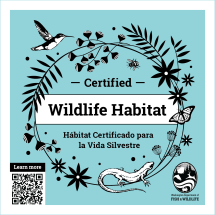
5. Recognize your habitat
Apply for a yard sign to recognize your small space as a wildlife habitat through our Habitat at Home Program. Habitat at Home is free and open to all Washington residents. For a national certification, check out the National Wildlife Federation's Certified Wildlife Garden Program.
Being a Good Neighbor
Be a good neighbor
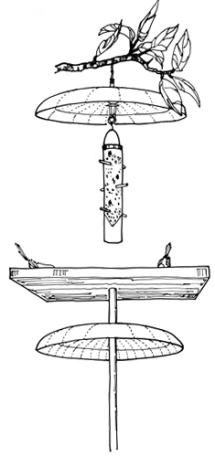
Consider neighbors when creating your habitat. Many small space habitats can be created in apartments, townhome, condos, duplexes, and more. It is important to consider the people around you as you plan to support the wildlife in your space.
Supporting more wildlife means bringing more wildlife into your space, so consider the impact to your neighbors, and their impact on the incoming wildlife. For example, if your immediate apartment neighbor has a severe bee allergy and you have linked balconies, you might want to consider wind-pollinated plants and a seed feeder for birds rather than bee-pollinated flowers.
Share your knowledge
Provide education if needed. Some people fear wildlife, often because they may be unfamiliar with local species and don't understand which animals do or do not pose a threat.
Be mindful of bird feeders and potential impacts
While hummingbird feeders are low impact, seed feeders can be very messy. Be sure you plan for the fallout, literally, of seeds, seed casings, and bird poop around neighbors. Find a feeder that catches all the seeds, so they don’t end up on neighbors' balconies. Messy feeders can also bring in rodents, especially in urban areas. Be aware of who is below and beside you and choose food-producing plants instead of feeders.
Encourage a group effort!
Wildlife habitat is best when it provides space for animals to move through areas safely, spread out from one another, and live peacefully. Collaborate with your neighbors and create habitat together! Flower boxes on neighboring balconies or rooftops, and plantings that connect at the edges all allow wildlife spaces to move through as they cross developed areas. Learn more about creating a community habitat in a shared space on our Community Habitats page.